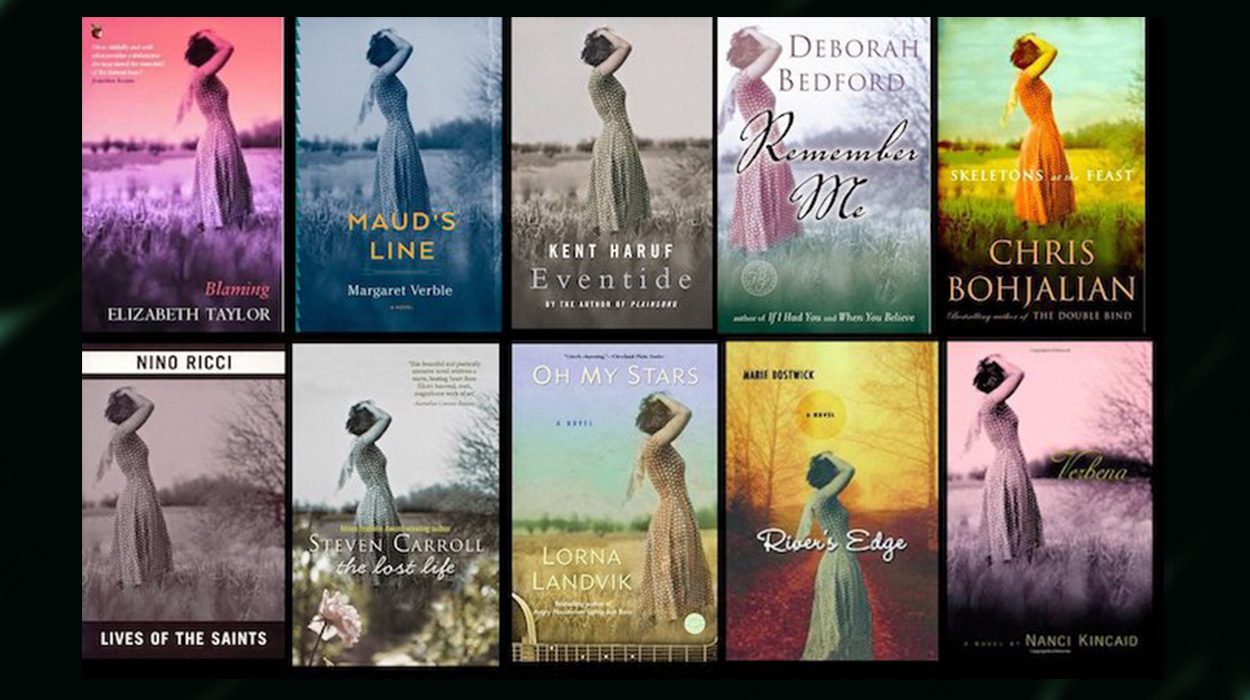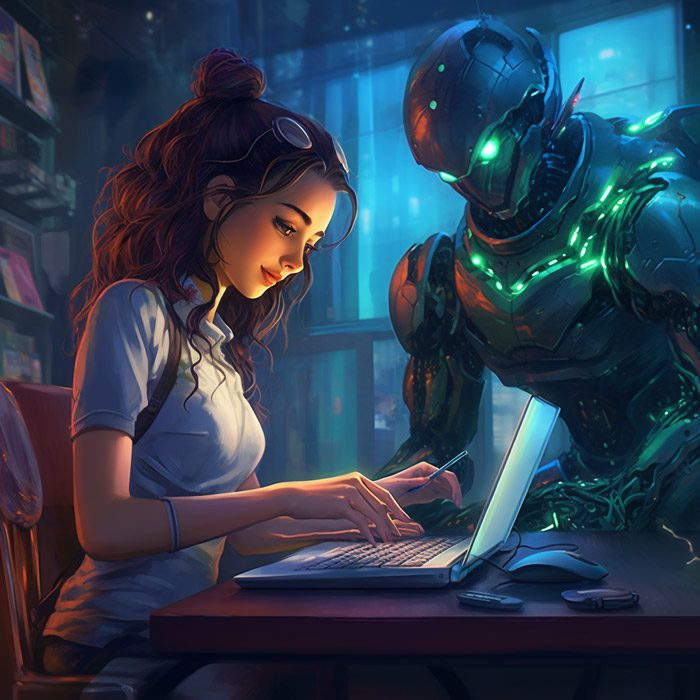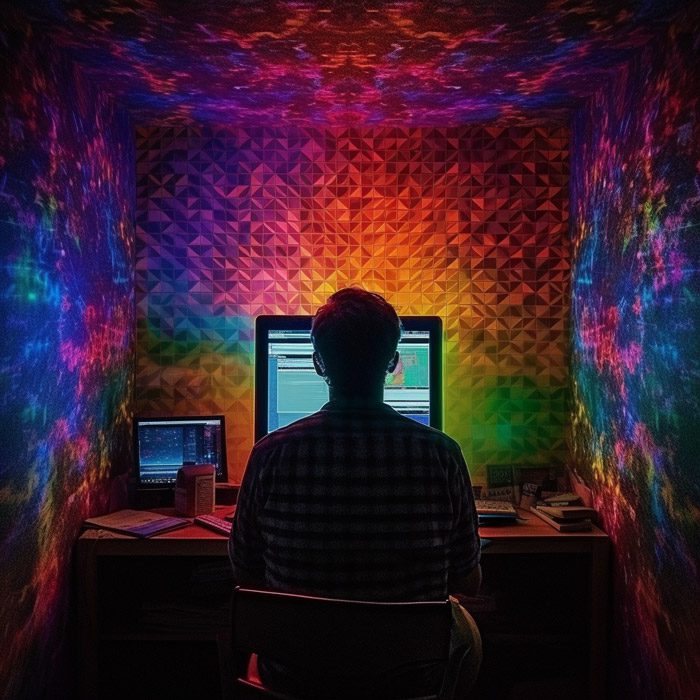Creativity.
Is it just a human trait?
Answer: yes and no.
Could a robot, for example, kick off an article with such a stunning, thought provoking haiku? Honestly, these days, yeah. And that’s not a bad thing.
Welcome to the fourth and final article in our series exploring generative AI in book cover design. From legalities to processes to ethical concerns, we’ve covered a lot so far, but I think we’ve saved the best till last.
If you haven’t already twigged, I’m rather excited about the prospect of using generative AI in book cover design.
Here’s why.
Efficient and effective
Generative AI, like all good tools, helps book cover designers work more efficiently and effectively. It can streamline the process and drive higher quality and more consistent outcomes.
The technology can seriously speed up the ideation process – type in a few carefully chosen words and our idea instantly comes to life, at which point we can decide whether or not it’s worth pursuing. If it is, we can then more quickly and easily play with the theme we’ve chosen, generating any number of versions until we find the perfect one. (Depending on your cover design package we offer up to four different first drafts.)
Sometimes – and this might come as a surprise – generative AI can slow us down. If an author has a clear idea of what they want their cover to look like, or if we feel a classic look will better align with the content of the book, it’s often far simpler to edit stock photos and images.
Why? Because creating a very specific output can be weirdly difficult with AI art. This AI artist, for example, took 17 hours to create an image in which he’s being punched by Muhammad Ali. At least we can all agree it was time well spent.
Unique and customisable
Most authors want their cover to be unique and memorable. Generative AI is awesome at ticking both boxes. As we’ve already covered in previous articles, generative AI doesn’t copy existing imagery or stitch it together. It learns the underlying rules and techniques and creates totally new things.
Until now most cover designers worked from the same source material: the stuff offered up by the major stock image sites. This led to inevitable double-ups; the same wispy, ethereal image of a fretful woman standing in a field, to pick an entirely random example.

When we use generative AI, an author is guaranteed to see something they, and everyone else on this planet, has never seen before. The overall look of the cover needs to reflect the genre, story and expectations of the audience – which is why book cover designers won’t be out of work any time soon – but we can now do literally whatever we want within these very broad boundaries.
We can also customise imagery in endless ways, to ensure the cover perfectly aligns with the author’s preferences – something that was either very tricky/time-consuming/costly or outright impossible to do with stock images.
A win for representation
You may have heard a major criticism of AI is the bias built into these systems. Type in ‘CEO’ and many systems will generate endless images of white, middle-aged men. Type in ‘nurse’ and the same systems will quickly switch to women.
But a lack of representation isn’t just an issue with AI – it’s an issue in stock images too. Indeed, stock imagery will have made up a significant portion of AI training data, thus contributing to the root cause of the issue.
The difference with generative AI versus stock images is that we can do something about it, because every image is made to order. In fact, we can boost representation to levels we’ve never dreamed of before. We can specify exactly what we want and we can overcome what were previously hard rails against depicting characters as their authors imagined them.
An Asian knight of the round table? No problem. A black, female pirate? Sure thing. An astronaut in a wheelchair? There’s simply no reason not to.
The absolute madness
The thing that blows my mind most about generative AI is that it can even make perfect sense of the perfectly nonsensical. When I say ‘it makes things that have never existed before’, I mean it. I can feed it utter garbage, nonsense prompts, and it somehow delivers accurate and wildly entertaining results. Consider the following styles that I totally made up:
A GlubCore fork

A Blendretti fork

A FutureTech fork

(Thanks to the Humble Nations blog for this idea – how do you like them apples.)
This scarcely believable level of creativity makes generative AI especially fantastic at the fantastical – creating things that have never before existed in the real world, and that would be all but impossible to piece together with stock images and elements.
I see generative AI as ushering in a golden era for book cover design in general, but I’m particularly excited about seeing how book covers transform in genres like sci-fi and fantasy.
The tech and its users will only get better
Take a quick look at the evolution of AI image generation:

The last image, which belongs in a gallery, was created around 12 months after the first, which looks like it may have been pulled from the Bristol stool chart. Now imagine for a moment what generative AI might be capable of producing in another 12 months, or 24 months, or five years. It honestly boggles the mind.
It’s not just the tools that are getting exponentially better – the users are too. Driving generative AI is a little like driving a car. In the beginning it feels unnatural and you stall an embarrassing amount, often in front of groups of merciless teenagers. (No? Just me?) But you begin to get comfortable, and eventually it feels like second nature.
To be honest, most AI drivers, myself included, are still on their learner licence. But my aim, and the aim of every designer, should be to eventually feel like Lewis Hamilton – a highly skilled professional piloting a high performance machine.
Some final thoughts
The way I see it, there are two main elements to artistic endeavours like writing and cover design: imagination and creation.
Previously imagination and creation were tied together, as the production of art demanded that one lead to the other. But in generative AI we can see that they are very different, very separate processes.
Imagination is a deeply human trait. It comes from deep within our consciousness, from an area that modern science still struggles to understand, and that technology has always failed to replicate. Machines can’t have ideas.
What technology has started to replicate is what many artists see as the labour of their craft: creation. Generative AI streamlines the process of turning imagination and ideas into reality.
Whether you see this as a good thing or bad thing is not for me to say. But no matter where you stand, it’s happening, and it’s happening fast. In my eyes this isn’t a bad thing, because AI will never replace true art or true artists. It will, however, make artists better.
And if you aren’t on board just yet, no stress. We’ve ensured you can opt out with the tick of a box.
***
To those who have read all four articles in this series, thank you for joining me on this journey. I truly hope it proved valuable to you. For those who have not, and who have just eaten dessert before their appetiser, entree and main like some kind of animal, you can check out the previous pieces here:
Also, for anyone who might be wondering, no, I did not use AI to write these pieces – every character was keyed in by 100% organic, flesh and bone human fingers!







3 Responses